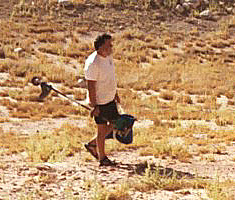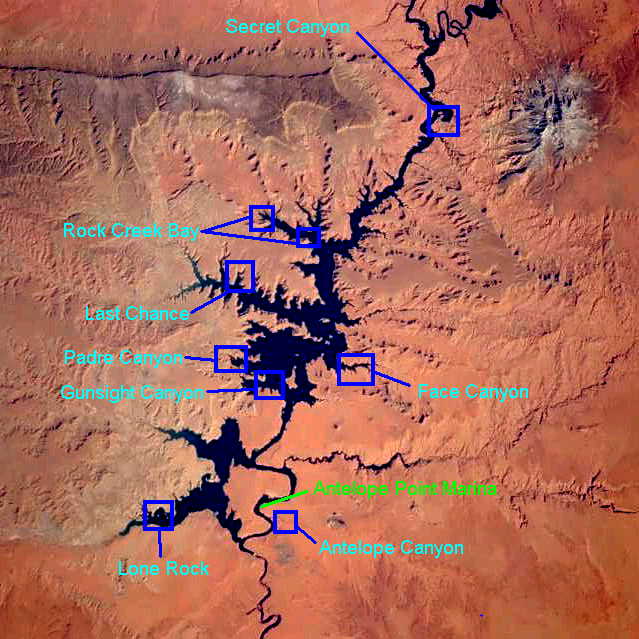G.R.I.T. Trip Report 2004
What It Is
G.R.I.T. stands for the Graffiti Removal and Intervention Team, a volunteer program of the National Park Service wherein volunteers participate in the removal of graffiti that other careless visitors have left on the rock walls of Lake Powell. For a period of five days, the NPS provides, at no charge to volunteers, a houseboat and fuel, tools for graffiti removal, and a pontoon boat for local area travel while the houseboat is parked. In exchange, volunteers agree to work a minimum of 24 hours during those five days on graffiti abatement activities.
I served as a captain in this program in the summer of 2004 for three separate small groups of volunteers. This program has nothing to do with my private houseboat, Wildwind II.
Volunteers clean graffiti from
the back of Rock Creek Bay:
Pre-GRIT Training
Before a prospective pilot is allowed to operate a government-owned boat, he or she must first attend and pass the Department of Interior Motorboat Operator Certification Course (DOI-MOCC). I attended this course in May of 2004, in a session held at Lake Powell.
When my volunteer time with the GRIT program arrived, the first task was to move the NPS houseboat, named “True Grit,” from its old base at Bullfrog to its new one at Antelope Point, from where my trips were to originate. That job started with meeting NPS Volunteer Coordinator Lisa Dittman for an early morning light plane flight from Page, landing in Bullfrog just twenty minutes later. I was busy taking as many photos of the lake as I could as we flew. As soon as we arrived, we immediately boarded the houseboat, fueled it up, and started back for Page.
Part of the purpose of this trip was to train me as the leader of other volunteers on the GRIT program. Since GRIT activities include searching for, documenting, and removing graffiti, we did small amounts of each of these. Another GRIT activity is educational, meeting with neighboring houseboaters at their campsites and telling them about the program and about graffiti law in general.
The first night we spent at Oak Bay amid several other houseboats. So right away my GRIT training began with public relations, as we visited other campers and extolled the GRIT program to them. In the morning we explored neighboring canyons for graffiti in the pontoon boat, and guess what! we found some graffiti in adjacent Secret Canyon. We removed it according to Park Service procedures, which basically involve wire brushes and elbow grease. I also became familiar with the official record keeping forms.
Then we moved the houseboat downlake to Padre Canyon and the next day took the pontoon boat into the canyon's inner reaches to find a major graffiti site – an impossibly huge site that was to take up most of my three trips’ graffiti removal time. It could easily have taken more. The site was so dauntingly huge that as we later that day brought the boat down to Antelope Point Marina my mind was already thinking that there had to be a better way.
The Knob in Padre Canyon:
The Machine
As I mentioned, the approved method of graffiti removal relied on wire brushes and elbow grease. That method was not going to make it for this one site in Padre  Canyon, considering just how much graffiti there was there. And a power washer or sand blaster wasn’t going to make it into the NPS budget this year or next, never mind the problem of how to schlep such a contraption up the hill to the graffiti. So I went over to Wal-Mart and bought a gasoline-powered weedwhacker. Then I took it over to the local hardware store and started fiddling around with their adapters and wire brushes until I eventually got a wire brush attached to the end of the weed whacker where the nylon string had originally been. Look out graffiti - now I have a gasoline powered wire brush! As it later turned out, “The Machine” was a bit too fast and too rough on the rock, and it demanded quite a bit of practice not to make the graffiti removal worse than the original graffiti. But eventually I learned to operate it somewhat artistically, and over the course of the three volunteer trips it removed all the graffiti at that formerly impossibly huge site.
Canyon, considering just how much graffiti there was there. And a power washer or sand blaster wasn’t going to make it into the NPS budget this year or next, never mind the problem of how to schlep such a contraption up the hill to the graffiti. So I went over to Wal-Mart and bought a gasoline-powered weedwhacker. Then I took it over to the local hardware store and started fiddling around with their adapters and wire brushes until I eventually got a wire brush attached to the end of the weed whacker where the nylon string had originally been. Look out graffiti - now I have a gasoline powered wire brush! As it later turned out, “The Machine” was a bit too fast and too rough on the rock, and it demanded quite a bit of practice not to make the graffiti removal worse than the original graffiti. But eventually I learned to operate it somewhat artistically, and over the course of the three volunteer trips it removed all the graffiti at that formerly impossibly huge site.
Areas Visited

I have marked this space shuttle photograph of the lower lake with the locations where we removed graffiti. In addition to a large graffiti site in Padre Canyon, we also cleaned areas of Secret Canyon, Rock Creek Bay, Last Chance Bay, Face Canyon, Gunsight Canyon, Antelope Canyon, and the side of Lone Rock.
Typical Trip
Although other captains may run their trips differently, a typical trip with me went something like this:
- 1st day
After introductions and orientation to the houseboat, safety instruction, and a welcoming speech by the NPS, we got underway. Each of my trips initially went to the back of Padre Canyon because of the huge graffiti site there, which we called the Knob, and which took all three trips to clear of graffiti. We anchored the houseboat, and after lunch, motored over to the site for 4 hours of removal. Then a swim, a great dinner, and we were ready for bed.
- 2nd day
We usually headed back to the graffiti site in the morning for another 4 or 5 hours of removal. We generally stopped working on this site for the rest of the trip when the sand generated by the removal process got so deep as to obscure the rest of the graffiti from further removal efforts. Fortunately, a wind and rain storm always seemed to pass through the area between each trip to blow and wash the sand away. In the afternoon we would explore various side canyons looking for new graffiti. If we found some, we would make a GPS record of it, both to document our activities and also so that others could positively find the site later if necessary.
- 3rd day
Sometimes there was more work to be done on the Knob. On other trips, we looked for and eradicated graffiti in other locations. All in all, we removed graffiti in Gunsight Canyon, Rock Creek Bay, Last Chance Bay, Face Canyon, Antelope Canyon, and the side of Lone Rock. In addition, we ended up checking out West Canyon, Kane Creek, Kane Wash, and several of the smaller canyons surrounding Dangling Rope Marina. Hiking in Face Canyon in particular was interesting because of its long narrow slot canyon recently revealed by the receding lake waters.
Some views of our hikes:
- 4th day
Like the day before, we split the day between graffiti removal and canyon exploration. We also spent some PR time in the area, meeting with other houseboaters camped nearby, and telling them about the GRIT program. The third trip was different, because we had discovered a heartbreakingly huge graffiti panel in Rock Creek Bay which was situated right of the top of an ancient Anasazi rock art site. We worked all day on this panel, and by the end, with the aid of “The Machine,” we had removed nearly all of the 2000+ square feet of graffiti.
Aerial view of the Rock Creek alcove: - 5th day
The fifth day was always leisurely, as we had completed our required work time obligations by then. A morning swim, a fine breakfast, and we broke camp and eventually made it back to the marina. After cleaning the boat for the next crew and filling out the program evaluations, we bid our farewells.
Morning coffee amid the scenery
Volunteer!
This program could always use additional energetic and dedicated volunteers. If you would like to take part in the GRIT program, check out the program web page at the National Park Service, and then follow the instructions there. Tell the new NPS Volunteer Coordinator Betsy Scroggs I sent you!
Return to main Lake Powell page
All images and content copyright ©2004 David Herberg. All rights reserved.
This page last modified on 25-Jan-2005
| You are visitor | since November 8, 2004 |